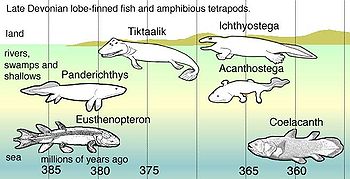
Rhipidistia
Encyclopedia

Crown group
A crown group is a group consisting of living representatives, their ancestors back to the most recent common ancestor of that group, and all of that ancestor's descendants. The name was given by Willi Hennig, the formulator of phylogenetic systematics, as a way of classifying living organisms...
of the Sarcopterygii
Sarcopterygii
The Sarcopterygii or lobe-finned fishes – sometimes considered synonymous with Crossopterygii constitute a clade of the bony fishes, though a strict classification would include the terrestrial vertebrates...
.
Taxonomy
Rhipidistia- Dipnomorpha
- †PorolepiformesPorolepiformesPorolepiformes is an order of prehistoric lobe-finned fish which lived during the Devonian period . The group contains two families: Holoptychiidae and Porolepididae....
- †PowichthysPowichthysPowichthys is a genus of prehistoric lobe-finned fish which lived during the Devonian period. This fish it was small in size, about 30 cm....
- †Powichthys
- Dipnoi
- †Porolepiformes
- TetrapodomorphaTetrapodomorphaTetrapodomorpha is a clade of vertebrates, consisting of tetrapods and their closest sarcopterygian relatives that are more closely related to living tetrapods than to living lungfish...
- †RhizodontRhizodontRhizodonts are an extinct group of predatory lobe-finned fishes. They are known from many areas of the world from the Givetian through to the Pennsylvanian - the earliest known species is about 377 Ma, the latest around 310 Ma. Rhizodonts lived in tropical rivers and freshwater lakes and were the...
iformes - Osteolepidida
- Osteolepiformes
- †TristichopteridaeTristichopteridaeTristichopterids , were a diverse and successful group of tetrapodomorph fishes throughout the Late Devonian stage. They first appeared in the Givetian epoch of the Middle Devonian stage...
- ElpistostegaliaElpistostegaliaElpistostegalia or Panderichthyida is an order of prehistoric lobe-finned fishes which lived during the Late Devonian period . They represent the advanced tetrapodomorph stock, the fishes more closely related to tetrapods than the osteolepiform fishes...
- †PanderichthysPanderichthysPanderichthys is a 90–130 cm long fish from the Devonian period 397 million years ago, of Latvia. It is named after the german-baltic palaeontologist Christian Heinrich Pander. It has a large tetrapod-like head...
- Tetrapoda
- †Panderichthys
- †Tristichopteridae
- Osteolepiformes
- †Rhizodont
However it is common to see Tetrapoda and Rhipidistia as sibling groups within Gnathostomata
Gnathostomata
Gnathostomata is the group of vertebrates with jaws. The term derives from Greek γνάθος "jaw" + στόμα "mouth". Gnathostome diversity comprises roughly 60,000 species, which accounts for 99% of all living vertebrates...
.

